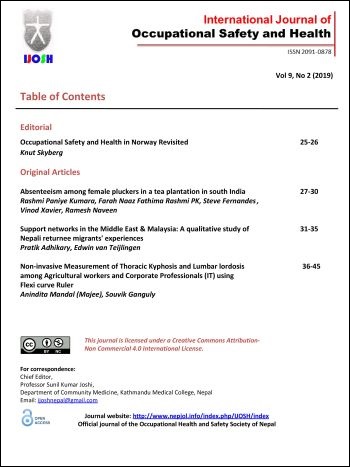Non-invasive Measurement of Thoracic Kyphosis and Lumber lordosis among Agricultural workers and Corporate Professionals( IT) using Flexicurve Ruler
DOI:
https://doi.org/10.3126/ijosh.v9i2.25884Keywords:
Kyphosis, Lordosis, Flexicurve Ruler, Agricultural worker, IT workersAbstract
Background: This study was undertaken to introduce a non- invasive technique for clinical diagnosis of spinal cord deformities. The purpose of the present study is to evaluate the postural deformities and onset of thoracic Kyphosis and lumber Lordosis among agricultural workers and Information Technology workers.
Methodology: This cross-sectional study was carried out on thirty Agricultural workers (41-45 years) and twenty-five Information Technology workers (21-25 years) and their age matched control groups. The subjects were taken from their respective population by simple random sampling method. Measurements were made by Flexicurve Ruler in special standing posture. Kyphosis and Lordosis angles and Indices were calculated.
Results: It indicates that maximum percentage of subjects had kyphotic angle between 400 -600. Twenty-three out of 30 agricultural workers (76.66%) and 22 out of 25(88%) information technology workers had kyphosis angle between 400- 600 but the same in case of control groups were 60% and 64% respectively. Maximum subjects had lordotic angle between 300 - 500. Thirteen out of 30 agricultural workers (43.33%) and 17 out of 25 information technology workers (68%) had lordotic angle in between 300 -500.The same in case of control groups were 43.33% and 56% respectively. Kyphosis index, Kyphosis angle and lordosis index, lordosis angle are significantly lower (p<0.05) in agriculture workers in comparison to its control group but the differences are not significant in case of information technology workers as well as between agriculture group and information technology group. But information technology workers show higher values of Kyphosis and lordotic index than agriculture workers, probably due to prolong sitting posture at work. Again 47% agricultural workers and 11% IT workers reported lumbar pain when compared to control groups (10% and none respectively).
Conclusion: Although no significant deviation of kyphotic and lordotic angle has been observed in agricultural and information technology workers but significantly higher percentage of these 2 groups reported shoulder and lumbar pain indicating risk of dysfunction in shoulder, pelvic girdle and spine. Thus measurement of thoracic kyphosis and lumbar lordosis may be useful in examining the degree of spinal cord deformities. By utilizing these information therapeutic and ergonomic intervention can be applied and application of modern sophisticated machine for improvement in postural condition can reduce their work stress and disabilities.
Downloads
Downloads
Published
How to Cite
Issue
Section
License
This license enables reusers to distribute, remix, adapt, and build upon the material in any medium or format for noncommercial purposes only, and only so long as attribution is given to the creator.





